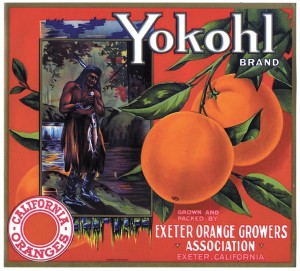This column first appeared in September 2010.
Paper labels from 1880-1930, collectively referred to as “Crate Art,” are a unique form of American Folk Art. Originally designed to be glued to the ends of wooden crates to identify produce during shipping, the graphically attractive labels are still attainable at a reasonable price, and worthy of consideration for your “items to watch for” list.
Stone lithography, used on the earliest labels, was a very involved process requiring a separate stone for each color used. By combining five primary tones, as many as fifty different colors could be produced. In 1930 the lithography process switched from stone to metal plates. The examples before 1930 that are the ones that are of interest to collectors.
Labels used on old cigar boxes were popular with collectors as early as the Victorian era. By 1870 there were thousands of brands of cigars being produced in the United States, providing a wealth of labels to choose from. Examples from this time frame featured up to twenty different colors on a single label. Embossed designs with gold highlights are a common find. Many of the cigar box labels from 1880-1920 feature images of popular political figures, with Lincoln being a favorite. Sports themes and hobbies are also prevalent with gentleman playing golf, cards or checkers.
Fruit crate art has increased in popularity over the past decade, as an appreciation for primitives of all types has caught the interest of the collecting public. The fruit and vegetable growers of California led the way with this form of advertising in the late 1800s. Their use of colorful lithograph labels was an instant hit with the public, sending the sale of produce soaring. It is no wonder that their competitors in the southern and midwestern states took notice and soon followed suit. By the early 1900s all of the over 2,000 citrus, apple and pear growers in America were offering their version of a crate label. Spanish Senoritas, landscapes, ocean scenes, and even Santas graced the sides of crates through the years. Very early examples are found with more romantic themes, featuring cupids and portraits of very finely dressed ladies.
The size and the delicacy of fruit and vegetable determined the size of crate in which it would be packaged. For example, tomatoes and grapes could not be stacked as high as lemons or oranges. Therefore, they were packed on long narrow “lug boxes.” Grape and tomatoes labels will be about 5” x 14” in size, apple and orange labels are normally 10” x 11”, lemon labels 9” x 12”, pears 8” x 10”, and standard vegetable labels are 5” x 7” or 7” x 9”. Reproduction labels will often not conform to these size specifications.
A poll taken in 1918 showed that it was more important to attract the male wholesaler than the housewife. As a result, you will find that labels printed after 1918 tend to show a more seductive female form than those issued earlier. It is also interesting to note that most labels were designed to be appreciated as “art,” and seldom, if ever, had anything to do with the content of the crate.
The price of a label is determined by rarity, age, condition and graphic appeal. Labels are still rather easy to find due the nature of the original purpose. They were printed on acid free paper, and made to withstand the abrasion and dampness of the refrigerated railroad cars that carried them to their destination. Until next time . . . Linda
Linda Kennett may be reached at 317-258-7835 or lkennett@indy.rr.com



